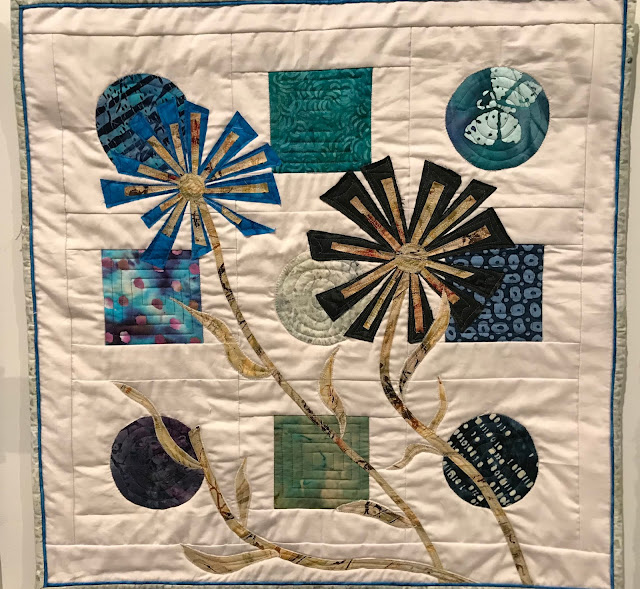Memphis, TN (not so far from Paducah, KY!) boasted an amazing quilt show at Crosstown Concourse, an equally amazing location in midtown Memphis that is worth a visit in itself. The building is a former Sears warehouse/fulfillment center that has been converted into a multi-use complex that maintains much of the building's history and includes retail, apartments and condos, a charter high school, and Crosstown Arts, a nonprofit mecca for artists in many media and those who appreciate the arts.
In June and July Crosstown Arts hosted its first annual quilt show, "Stitched". With family in Memphis, I was dying to go, but had to wait until nearly the end. What a blast! The show included a curated show of art quilts, a display of quilts made by local quilters with specific parameters required, and a film with interviews of quilters in both groups.
At the top of the winding staircase on the second floor at Crosstown, a visitor is greeted by a wall of squares and half-square triangles and invited to create a quilt. What a great opportunity for people to discover how quilts come together and to enjoy creating a "quilt" without even knowing how to sew!
The show featured 29 quilts in the Art Quilts galleries and another 200+ from the local-ish quilters. Not all quilts are included. I've divided the photos into three posts, since the number of photos would make the posts unmanageable. The descriptions of the art quilts are from the program, in the words of the quilters. Full acknowledgments to the quilters and to Crosstown Arts.
Art Quilts, Part 1
Composition IX, Deidre Adams (Littleton, Colorado)
" ...my effort to find a quiet place within while paying homage to forces greater than myself. What we have learned about our world through science is balanced by the mysteries of the unknown and the sense of wonder at what we have yet to discover."
 |
| 46" x 48", commercial fabrics and acrylic paint |
Round and Round It Goes, Paula Kovarik (Memphis, Tennessee)
[This is an astounding piece of art. The quilter provided little description, perhaps because it is beyond words]
 |
| Repurposed table cloth free-motioned quilted, 54" diameter |
 |
| Above and below, close-ups of Round and Round |
We, Elly van Steenbeek (Veenendaal, the Netherlands)
"Two parts
Different
But also common
Connected
One piece together
After so many years
WE"
 |
| Altered cotton with rust and tea...monoprinted, hand-stitched, machine-stitched and quilted. |
 |
| Close-up of We |
My Mended World, Judy Martin (Ontario, Canada)
"Made with community assistance as part of the Manitoulin Circle Project."
 |
| Hand-pieced, machine-pieced, hand quilted, hand embroidery. |
 |
| Close-up of My Mended World |
Waking Up, Judy Rush (Bexley, Ohio)
"Waking Up is an exploration of how seemingly disparate parts come together and somehow make sense. The pieces are sewn onto a background one by one, encouraged to interact with one another. The stitching acts to blend shapes and colors as well as to hold all the pieces together."
 |
| (This reminds me of an African village, with small plots of gardens near the huts.) |
November 2, 2012 - February 4, 2013, Toot Reid (Tacoma, Washington)
"I want to convey the depth and subtlety of life. How parts of our lives fit together to make a whole."
 |
| Note that the quilt is constructed and hung in four separate pieces. |
Generated Topology, Kathy Weaver (Highland Park, Illinois)
"In Generated Topology, there is a world full of magnified, fantastic organisms. Using this exaggerated scale I invite viewers to imagine themselves as emotive nanorobots exploring alien environments."
 |
| Satin, airbrushed, hand-quilted. 42" x 48" |
 |
| Close-up of Generated Topology |
Sine Me Up, Kent Williams (Madison, Wisconsin)
"I call this quilt "Sine Me Up" because the piecing arranges itself into a series of overlapping sine curves. Putting it together required a lot of measuring -- down to eighths of an inch."
 |
| Look closely. Note that there are no curves in the actual sewing. The curves are a trick of vision. |
 |
| Close-up of Sine Me Up |
Translucency and Kaleidoscope, Judith Larzelere (Westerly, Rhode Island)
"After 33 years of using the tools of color theory and intensely saturated colors, I embarked on an exploration of translucency and delicate, ephemeral hints of tone."
 |
| The depth of shading in this quilt changes according to the viewer's distance. The close-up below shows how the quilter achieved the on-point squares. |
 |
| Close-up of Translucency and Kaleidoscope |
To be continued...































































